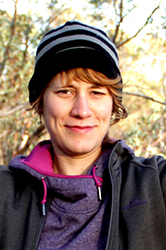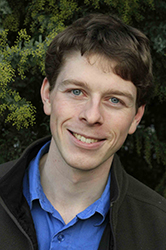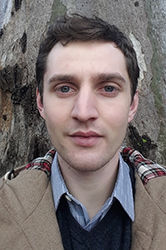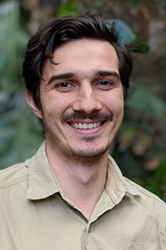Insect ecology
Gibb lab
Post Doctoral Researchers
 Orsi Decker
Orsi Decker
My main interest is in small and sometimes invisible creatures beneath our feet: soil invertebrates and microbial organisms. They are playing crucial roles in our ecosystems; however, they are hardly recognised for their hard work. In my projects, I am trying to understand this underrated universe belowground and use our data to conserve and restore habitats from the ‘bottom up’.
Currently, I am involved in exciting large-scale projects, looking at impacts of digging mammals on soil fauna communities.
I am also working on various restoration projects, such as exploring the possibilities of invertebrate and microbe rewilding (led by H. Gibb); or linking soil properties to suitable mallee habitat for endangered birds (Mike Clarke).
Recently, I joined another team of invertebrate-lovers (Pete Green, Nick Murphy, Victorian Museum and Australian Museum) where I get to collect endemic snails in south-eastern Australia and investigate how the recent bushfires (2019/2020) affected their distribution.
 Joshua Grubb
Joshua Grubb
I am a postdoctoral researcher in DEEE. Under the supervision of Prof. Heloise Gibb, Dr Nick Murphy and Dr Richard Marchant, my PhD investigated the effects of the 2009 ‘Black Saturday’ fires on the invertebrate detritivores.
Following my PhD, I began work on a project led by Prof. Heloise Gibb measuring the effects of the 2020 fires on litter and log invertebrates in rainforest in SE Australia. In particular, this project aims to identify species that are endemic to rainforest through morphological and genetic identification, as well as testing the efficacy of leaf litter transplants on invertebrate recovery after severe fire.
Postgraduate Students
 James Buxton
James Buxton
The functional significance of ant colouration
Ants are of immense ecological importance and can be strikingly colourful, ranging from diaphanous yellows to intense reds. James is exploring the colour diversification of ants from a functional perspective in order to identify associations between colour traits and the environment. This will be achieved through a broad variety of approaches including field comparisons, behavioural trials, manipulative experiments, ultrastructural investigations, and visual modelling. This novel approach will potentially enable the development and application of colour-related traits in trait-based ecological studies, as well as contribute to our understanding of animal colouration more generally.
Supervisors: Prof. Heloise Gibb, Dr. Kylie Robert, and Prof. Mark Elgar (University of Melbourne).
 Peter Contos
Peter Contos
Rewilding invertebrates and microbes for biodiversity and ecosystem function
Restoration ecology has historically focused on reconstructing highly visible groups (e.g., plants, vertebrates) whilst ignoring less visible ones, such as invertebrates and microbes. This is problematic as invertebrates and microbes make up the vast bulk of biodiversity and drive many key ecosystem functions. Yet, they are rarely actively reintroduced when they struggle to recolonise restoration sites, limiting ecosystem function and biodiversity in these areas.
My project responds to this shortfall by investigating how we can rewild dispersal-constrained invertebrates and microbes during ecological restoration. My research looks at the efficacy of inoculating restoration sites with litter transplants from biologically rich remnant sites, and its effect on biodiversity and the efficiency of leaf litter breakdown.
Supervisors: Prof. Heloise Gibb and Dr Nick Murphy
Former students
Joshua Grubb (PhD) Going through hell: The drivers of detritivore recovery after fire
Orsi Decker (PhD) Cascading effects of the native fossorial critical weight range mammals on soil ecology and function
Nicole Coggan (PhD) What are the effects of reintroducing ecologically extinct mammals on invertebrates in increasingly arid habitats?
Sebastian Buckingham (PhD) The effects of fire severity on composition and function of leaf litter-dwelling macroinvertebrate detritivores.
Katayo Sagata (PhD) Climate effects on ant-Hemiptera-plant interactions, ant richness and morphology.
James Buxton (Honours 2015) – An investigation into the function of pilosity and sculpturing in ants. Co-supervised by Kylie Robert (La Trobe University).
Kate Arnold (Honours 2015) – Post-fire recovery of cockroaches (Blattodea) is limited by distance in sclerophyllous woodlands. Co-supervised by Nick Murphy (La Trobe University).
Iona Okey (Honours 2014) – The effect of altitude on ant assemblage traits in the Australian Alps.
Melissa Van De Wetering (Honours 2013) – Nest relocation in beauty ants, Calomyrmex purpureus. Co-supervised by Dr Ajay Narendra (ANU). Melissa is now undertaking a PhD in the Insect Ecology Lab.
Simon Verdon (Honours 2012) – Mammal ecosystem engineers can limit plant recruitment and alter plant composition in the arid zone? Co-supervised by Steve Leonard (La Trobe University). Simon is now undertaking a PhD at La Trobe University.
Louise Menz (Honours 2012) – Amphipod population structure and tolerance to fire in a fire-prone landscape. Co-supervised by Nick Murphy (La Trobe University).
Blair Grossman (Honours 2011) – Does the reintroduction of native omnivores affect invertebrate regulation of soil structure and function? A collaboration with the Australian Wildlife Conservancy. Co-supervised by Matt Hayward (AWC). Blair is now employed in the Insect Ecology laboratory at La Trobe University.
Colin Silvey (Honours 2011) – How does reintroduction of threatened native omnivores affect arachnid assemblages? Collaboration with the Australian Wildlife Conservancy. Co-supervised by Matt Hayward (AWC). Colin is now employed at Museum Victoria.
Philip Barton (PhD 2010) – How do we restore degraded bushland? Getting the insects back for function, food and biodiversity. Co-supervised by Professor David Lindenmayer and Dr Adrian Manning (ANU) and Saul Cunningham (CSIRO). Philip is now employed as a postdoc in Professor David Lindenmayer's group at the ANU.
Daniel Muscat (Honours 2010) – Does climate drive spider morphology and web architecture? – completed 2010. Co-supervised by Dr Nigel Andrew (UNE) and Associate Professor David Warton (UNSW).
Christopher Churcher (Honours 2010) – Home range and habitat selection by reintroduced numbats, Myrmecobius fasciatus, in Scotia Sanctuary, NSW – completed 2010. Co-supervised by Matt Hayward (AWC).
